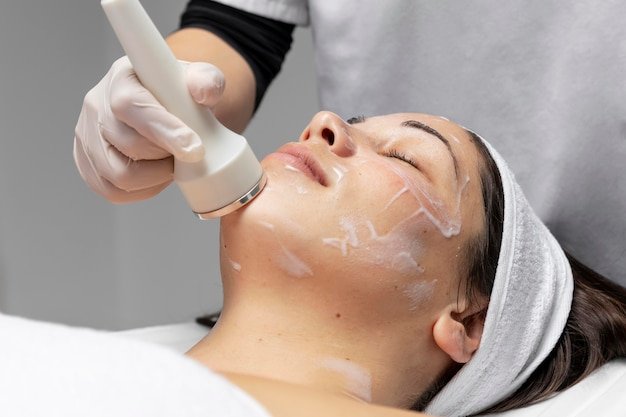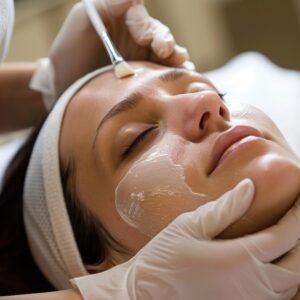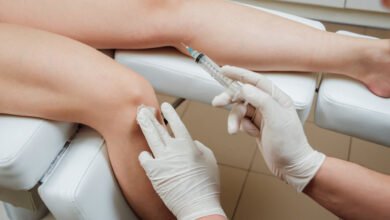
In the pursuit of radiant, youthful skin, many individuals turn to various skincare treatments. Among these, professional chemical peels have gained significant popularity due to their effectiveness in addressing a wide range of skin concerns. This article will explore what chemical peels are, their benefits, the different types available, the procedure itself, aftercare tips, and why they are an excellent choice for achieving glowing skin.
Understanding Chemical Peels
What Is a Chemical Peel?
A Chemical peels in Abu Dhabi is a cosmetic procedure that involves applying a solution to the skin to exfoliate and remove the outer layers. This process promotes the growth of new, healthier skin, resulting in a more radiant complexion. Chemical peels can vary in strength, depth, and formulation, catering to different skin types and concerns.
How Do Chemical Peels Work?
Chemical peels work by using a combination of acids that dissolve the bonds between dead skin cells, allowing them to be sloughed away. The depth of the peel determines the extent of exfoliation and the resulting skin renewal. This process encourages the regeneration of collagen and elastin, essential proteins for maintaining skin elasticity and firmness.

Benefits of Professional Chemical Peels
1. Exfoliation and Renewal
One of the primary benefits of chemical peels is their ability to provide deep exfoliation. By removing dead skin cells, peels reveal fresher, healthier skin underneath, which can improve texture and tone.
2. Treatment of Skin Concerns
Chemical peels effectively address various skin concerns, including:
- Acne and Acne Scars: Peels can reduce acne breakouts and fade post-acne marks.
- Hyperpigmentation: They help diminish dark spots and uneven skin tone.
- Fine Lines and Wrinkles: Chemical peels can smooth out fine lines, offering a more youthful appearance.
- Sun Damage: Peels can reverse some effects of sun exposure, such as rough texture and discoloration.
3. Improved Skin Texture
Regular chemical peels can lead to smoother skin texture, reducing the appearance of pores and improving overall complexion.
4. Boosts Product Efficacy
By removing the outer layer of dead skin, chemical peels enhance the absorption of skincare products, allowing serums and moisturizers to penetrate deeper and work more effectively.
Types of Chemical Peels
1. Superficial Peels
These peels use mild acids, such as alpha hydroxy acids (AHAs), to exfoliate the outermost layer of skin. They are ideal for individuals looking for a gentle refresh and can be done frequently with minimal downtime.
2. Medium Peels
Medium peels penetrate deeper into the skin using trichloroacetic acid (TCA) or a combination of acids. They effectively treat moderate skin concerns, such as fine lines and sun damage, but may require a longer recovery period.
3. Deep Peels
Deep peels involve stronger acids and can treat severe skin issues, such as deep wrinkles and significant sun damage. These peels require a longer recovery time and are typically performed less frequently.
The Chemical Peel Procedure
1. Consultation
Before undergoing a chemical peel, a thorough consultation with a qualified skincare professional is essential. They will assess your skin type, discuss your goals, and recommend the most suitable peel for your needs.
2. Preparation
On the day of the procedure, the skin will be cleansed, and a protective barrier may be applied to safeguard the surrounding areas. The chosen chemical solution will then be applied to the treatment area.
3. Application of the Peel
The chemical solution will be left on the skin for a specific duration, depending on the type of peel. You may experience a tingling or warm sensation during this time, which is normal.
4. Neutralization and Post-Care
After the appropriate time has elapsed, the solution will be neutralized (if necessary), and soothing products may be applied to calm the skin. The provider will discuss post-treatment care to ensure optimal healing.
Aftercare Tips
1. Follow Post-Procedure Instructions
It is crucial to adhere to the aftercare instructions provided by your skincare professional. This may include avoiding sun exposure, using specific skincare products, and refraining from certain activities.
2. Hydration Is Key
Keeping the skin hydrated is essential for healing. Use a gentle moisturizer and drink plenty of water to support skin recovery.
3. Avoid Picking or Scrubbing
Resist the urge to pick at peeling skin, as this can lead to scarring or infection. Allow the skin to exfoliate naturally.
4. Sunscreen Protection
Using a broad-spectrum sunscreen is vital after a chemical peel. The skin will be more sensitive to the sun, and protecting it from UV rays is essential for preventing further damage.
Results and Expectations
1. Initial Results
Many individuals notice an immediate improvement in skin texture and brightness after a chemical peel. However, optimal results may take several days to weeks to fully appear as the skin continues to regenerate.
2. Longevity of Results
The longevity of results varies based on the peel type and individual skin concerns. Regular treatments can help maintain glowing skin over time.
3. Combining Treatments
For enhanced results, consider combining chemical peels with other skincare treatments, such as microneedling or facials, to further improve skin quality.
Conclusion
Achieving radiant skin is within reach through professional chemical peels. With their ability to exfoliate, treat various skin concerns, and promote a youthful appearance, chemical peels are a valuable addition to any skincare routine. By consulting with a qualified professional and following post-care guidelines, you can enjoy the many benefits of this effective treatment.
FAQs
1. How often should I get a chemical peel?
The frequency of chemical peels depends on the type used and your skin’s needs. Superficial peels can be done every few weeks, while medium and deep peels may be spaced out every few months.
2. Are there any side effects?
Common side effects include redness, peeling, and sensitivity, which typically subside within a few days. Following aftercare instructions can help minimize discomfort.
3. Can anyone get a chemical peel?
While most people can benefit from chemical peels, individuals with certain skin conditions or those taking specific medications may need to avoid them. A consultation with a professional can determine your suitability.
4. Will a chemical peel help with acne scars?
Yes, chemical peels can improve the appearance of acne scars over time. However, multiple sessions may be necessary for optimal results.
5. Can I wear makeup after a chemical peel?
It’s advisable to wait at least 24 hours before applying makeup to allow the skin to start healing properly. Always follow your provider’s specific recommendations.



